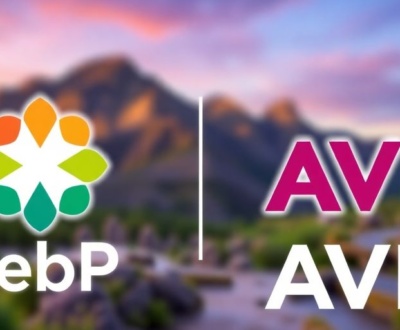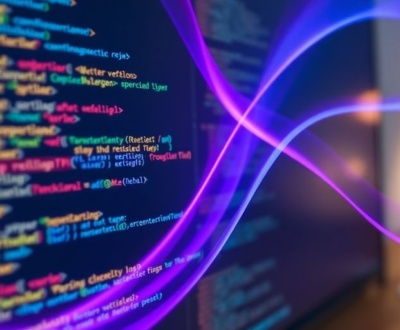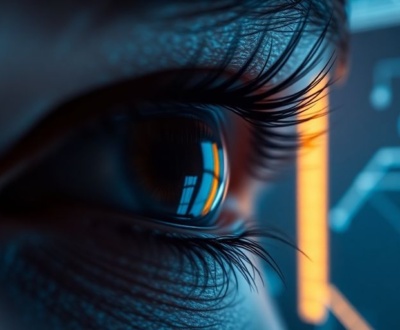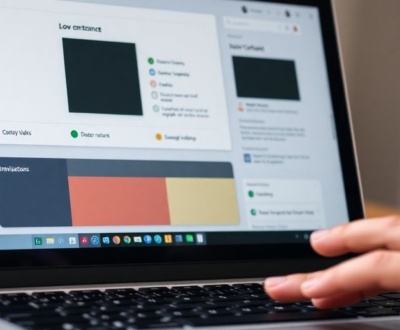Hey there! So, you know how web design can sometimes feel a bit… static? Getting those cool animations and transitions just right can be a real headache. But what if I told you there’s a new way to make things move without all the fuss? We’re talking about using AI video to prototype motion for your websites. It’s a pretty neat trick that can save you a bunch of time and help you see your ideas come to life way faster. This article is all about how you can use ai video motion prototyping web design to make your projects shine.
Key Takeaways
- AI video helps bridge the gap between just an idea and seeing how motion will actually look on a website.
- Choosing the right AI tools means looking at what they can do for animation and how they fit with your current design programs.
- Writing good prompts for AI video is super important; you need to be clear about what you want to see happen.
- Once you have an AI video prototype, you can show it to others and figure out how to make it work using regular web code.
- Starting with simple ideas and using AI to quickly try out different things can make your design process much smoother.
Understanding AI Video for Web Design Prototyping
Bridging the Gap Between Concept and Interactive Experience
Okay, so you’ve got this awesome idea for a website, right? Maybe it’s a slick animation or a cool transition. But how do you actually show people what’s in your head before spending a ton of time coding it? That’s where AI video comes in. It’s like a super-fast way to create a visual prototype. Instead of just describing your vision, you can actually see it. This is a game-changer because it helps everyone get on the same page early on. It’s about making the abstract concrete. Think of it as a quick sketch, but for motion. It lets you explore different ideas and get feedback without getting bogged down in the technical details. It’s all about speed and clarity.
The Role of AI in Streamlining Motion Workflows
Let’s be honest, creating motion for the web can be a pain. It often involves a lot of manual work, tweaking code, and endless revisions. AI video can seriously cut down on that. It automates a lot of the initial design work. You can use AI to generate different motion options based on a simple prompt. This means you can explore a wider range of ideas in less time. It also helps you identify potential problems early on, before you’ve invested too much time and effort. It’s like having a virtual assistant that can handle the grunt work, freeing you up to focus on the creative stuff. Plus, it can help you explore generative design options quickly.
Visualizing Complex Interactions with AI Video
Some web interactions are just plain complicated. Think about a multi-step form, a dynamic chart, or a complex animation sequence. Describing these interactions in words can be tough, and static mockups often don’t cut it. AI video lets you create a dynamic representation of these interactions. You can actually show how elements move, change, and respond to user input. This is incredibly helpful for communicating your vision to stakeholders, developers, and users. It makes it easier to get feedback and iterate on your designs. It’s all about making complex ideas understandable at a glance.
AI video prototyping isn’t about replacing traditional design methods. It’s about augmenting them. It’s a tool that can help you explore ideas faster, communicate more effectively, and ultimately, create better web experiences.
Choosing the Right AI Video Tools for Motion Prototyping

Alright, so you’re ready to jump into using AI for motion prototyping. Awesome! But before you do, you gotta pick the right tools. It’s like deciding between a hammer and a screwdriver – both can build, but one’s way better for certain jobs. Let’s break down what to look for.
Evaluating AI Platforms for Animation Capabilities
Not all AI video generators are created equal, especially when it comes to animation. Some are better at photorealistic scenes, while others shine with stylized animation. You need to figure out what kind of motion you’re trying to prototype. Is it a subtle hover effect on a button, or a full-blown animated explainer video?
Here’s a few things to consider:
- Animation styles: Does the platform support the style you need (e.g., 2D, 3D, motion graphics)?
- Control over motion: Can you control the speed, easing, and timing of animations?
- Customization: How much can you tweak the AI’s output to match your vision?
Integrating AI Video with Existing Design Software
This is a big one. You don’t want your AI video tool to be an island. It needs to play nice with the software you already use, like Figma, Adobe XD, or even your code editor. Think about how you’ll get the AI-generated video into your workflow.
Here are some integration methods to consider:
- Direct plugins: Some AI tools have plugins for popular design software.
- API access: Can you use the AI’s API to automate tasks or build custom integrations?
- Export options: What video formats does the AI support, and can you easily import them into your design tools?
Considering Output Formats for Web Implementation
Okay, you’ve got your AI-generated video. Now what? You need to make sure it’s in a format that works well on the web. This means considering file size, browser compatibility, and performance. A huge, unoptimized video will kill your website’s loading speed.
Here’s a quick rundown of common web video formats:
- MP4: Widely supported and generally a good choice.
- WebM: Optimized for the web and often smaller than MP4.
- GIF: Good for short, looping animations, but can be large.
Don’t forget about optimization! Use tools to compress your videos without sacrificing too much quality. Also, think about using video hosting platforms like YouTube or Vimeo to offload the bandwidth from your own server.
Crafting Effective Prompts for AI Video Generation
AI video generation is really cool, but it’s only as good as the prompts you give it. You can’t just type in a vague idea and expect something amazing. It takes some thought and a bit of experimentation to get the results you want. Think of it like talking to someone who can only understand very specific instructions. The clearer you are, the better the outcome.
Defining Motion Intent with Precise Language
The key to getting good AI video is being super specific about the motion you want to see. Don’t just say "a logo animation." Instead, try something like "a logo that fades in from the left, then rotates 360 degrees, and finally zooms out to reveal the company slogan." The more detail, the better. Think about the timing, the speed, and the style of the motion. Use action verbs and descriptive adjectives to paint a clear picture for the AI. For example:
- "Quickly fades"
- "Smoothly transitions"
- "Bounces playfully"
Also, consider the overall feeling you want to convey. Is it energetic and dynamic, or calm and sophisticated? Your language should reflect that.
Specifying Visual Elements and Transitions
Beyond the motion itself, you need to tell the AI what visual elements to use and how they should transition. Do you want a specific color palette? A particular font? A certain style of illustration? Be explicit. For transitions, think about fades, wipes, zooms, and other effects. Here’s a simple table to illustrate how different prompts can affect the output:
| Prompt | Expected Visual Element | Expected Transition |
|---|---|---|
| "Red circle fades in" | Red circle | Fade-in |
| "Blue square wipes from left" | Blue square | Wipe from left |
| "Green triangle zooms out" | Green triangle | Zoom out |
Don’t be afraid to get really detailed. You can even specify things like the type of lighting, the texture of the materials, and the overall composition of the scene. The more information you provide, the more control you have over the final result.
Iterative Prompting for Refined Results
AI video generation is rarely a one-shot deal. You’ll probably need to iterate on your prompts to get the exact result you’re looking for. Start with a basic prompt, see what the AI generates, and then refine your prompt based on the output. This is where the real magic happens. It’s a process of trial and error, but it’s also a great way to discover new ideas and possibilities.
Think of it as a conversation with the AI. You give it some initial instructions, it responds with a video, and then you give it more specific instructions based on what you see. This iterative process allows you to gradually refine the video until it matches your vision.
Here are some tips for iterative prompting:
- Keep track of your prompts and the corresponding outputs.
- Make small, incremental changes to your prompts.
- Don’t be afraid to experiment with different wording and phrasing.
- Use negative prompts to tell the AI what you don’t want to see.
Integrating AI Video Prototypes into Web Development
So, you’ve got this awesome AI-generated video showing off some slick motion design. Now what? How do you actually get that into a real website? It’s not as simple as just embedding a video, but it’s also not rocket science. Let’s break it down.
Showcasing Motion Concepts to Stakeholders
First things first, use that AI video to get everyone on board. It’s a fantastic way to communicate your vision without needing to build out a full interactive demo. Think of it as a super-charged mood board. You can easily share these videos with clients, developers, and other designers to get feedback and make sure everyone’s on the same page before any serious coding begins. It’s way easier to tweak a prompt and re-generate a video than it is to rewrite a bunch of JavaScript. This is where AI-assisted design workflows really shine.
Translating AI Video to CSS and JavaScript Animations
Okay, the video looks great, everyone loves it. Time to make it real. This is where the rubber meets the road. You’re not going to just embed the video (though you could for a placeholder). The goal is to recreate the motion using web technologies like CSS and JavaScript.
Here’s the process:
- Analyze the video: Break down the motion into its individual components. What’s moving? How fast? What are the easing curves?
- Recreate with CSS: Start with simple CSS animations for basic movements like fades, slides, and rotations. CSS is generally more performant than JavaScript for these kinds of things.
- Use JavaScript for complex interactions: If the motion is triggered by user input or involves complex calculations, JavaScript is your friend. Libraries like GreenSock (GSAP) can make this a lot easier.
- Optimize: Keep an eye on performance. Too many animations can bog down a website. Use techniques like hardware acceleration and requestAnimationFrame to keep things smooth.
Optimizing AI-Generated Motion for Performance
Performance is key. No one wants a website that lags and stutters. Here are some tips for optimizing your AI-generated motion for the web:
- Simplify animations: The more complex the animation, the more processing power it requires. Try to simplify animations where possible without sacrificing the overall effect.
- Use CSS transforms: CSS transforms (translate, rotate, scale) are generally more performant than animating properties like
leftandtop. - Hardware acceleration: Use the
transform: translateZ(0);trick to force hardware acceleration on elements with animations. This can significantly improve performance on some devices. - Debounce event listeners: If you’re using JavaScript to trigger animations based on user input (like scrolling), debounce the event listener to prevent animations from firing too frequently.
- Test on different devices: Make sure your animations look good and perform well on a variety of devices and browsers. What looks great on your high-end laptop might be a slideshow on someone’s older phone.
Remember, the goal is to create a smooth and engaging user experience. Don’t get so caught up in the fancy animations that you forget about the basics of web performance. A fast, responsive website is always better than a slow, flashy one.
Best Practices for AI Video Motion Prototyping
Starting with Low-Fidelity Motion Concepts
Don’t jump straight into high-resolution, fully polished AI videos. It’s a waste of time and resources. Begin with simple, low-fidelity prototypes to test your core motion ideas. Think of it like sketching before painting. These early prototypes should focus on the fundamental movements and transitions you want to achieve. This approach allows you to quickly iterate and refine your concepts without getting bogged down in details that might change later. It’s about validating the core idea before investing in the details.
Leveraging AI for Rapid Iteration Cycles
AI video generation shines when it comes to rapid iteration. Use this to your advantage. Don’t be afraid to experiment with different prompts, styles, and parameters. The goal is to quickly explore a wide range of possibilities and identify the most promising directions.
Here’s a simple workflow:
- Generate a video.
- Evaluate the results.
- Adjust the prompt.
- Repeat.
This iterative process allows you to refine your motion concepts much faster than traditional animation methods. It’s like having a super-powered brainstorming partner that can quickly visualize your ideas.
Documenting AI Video Motion Decisions
It’s easy to get lost in the rapid iteration process of AI video generation. That’s why it’s important to document your decisions along the way. Keep track of the prompts you used, the variations you explored, and the reasons why you chose certain directions over others. This documentation will be invaluable when you need to revisit your work later or explain your design choices to stakeholders. It also helps you learn from your experiences and improve your prompting skills over time. Consider using a simple spreadsheet or a dedicated project management tool to keep everything organized. This will help you avoid repeating mistakes and ensure that your AI video motion prototyping process is efficient and effective. For example, you can use a prototyping tool to keep track of your progress.
Think of your documentation as a design journal. It’s a record of your creative journey, capturing the insights and decisions that shaped your final motion design. This journal will not only help you stay organized but also serve as a valuable resource for future projects.
Overcoming Challenges in AI Video Motion Prototyping

Addressing AI Output Limitations
AI video generation is cool, but it’s not perfect. You’ll quickly find that AI has its limits. Sometimes the output just isn’t what you envisioned, and you’ll need to figure out how to work around it. This might mean tweaking your prompts a lot, or even using multiple AI tools and combining the results. It’s all about understanding what the AI can and can’t do, and adjusting your workflow accordingly. For example, if you’re trying to create a complex animation with lots of moving parts, the AI might struggle to keep everything consistent. You might need to break it down into smaller chunks and then stitch them together. Don’t expect perfection right away; experimentation is key.
Ensuring Brand Consistency in AI-Generated Motion
Keeping your brand consistent is super important, especially when you’re using AI. AI-generated content can sometimes go off-brand if you’re not careful. You need to make sure the AI is using the right colors, fonts, and overall style. This might involve feeding the AI examples of your brand guidelines or creating custom templates. It’s also a good idea to have a human review the AI’s output to make sure it aligns with your brand. Think about it like this: you wouldn’t let a robot design your logo without any oversight, right? The same goes for motion design. You can use AI to boost efficiency, but you still need a human touch.
Managing File Sizes and Loading Times
AI-generated video can be HUGE. And nobody wants a website that takes forever to load. You’ll need to optimize your videos to keep the file sizes down without sacrificing too much quality. Here are a few things you can try:
- Compress the video files.
- Use a lower frame rate.
- Optimize the video for web streaming.
It’s a balancing act. You want your motion design to look good, but you also want your website to be fast and responsive. Experiment with different settings and find the sweet spot that works for your project. Don’t be afraid to try different video formats too. Some formats are more efficient than others. Also, consider using a content delivery network (CDN) to serve your videos from a server that’s closer to your users. This can significantly improve loading times, especially for users in different parts of the world.
Future Trends in AI Video for Web Design
Advancements in Real-Time Motion Generation
Real-time motion generation is getting closer. Imagine being able to tweak animations live in your browser, with AI instantly responding to your changes. This would seriously speed up the prototyping process. It’s not quite there yet, but the progress is noticeable. We’re talking about tools that can generate complex motion graphics on the fly, based on simple inputs. This means less waiting, more experimenting, and a faster path to polished web designs. The ability to see changes instantly will be a game-changer for designers.
Personalized User Experiences Through AI Motion
AI can make websites feel more alive and tailored to each user. Think about animations that react to a user’s behavior, like scrolling speed or mouse movements. Or even better, animations that change based on the time of day or the user’s location. This level of personalization was difficult before, but AI is making it easier. It’s about creating a more engaging and intuitive experience for everyone. AI video trends are making this possible.
The Evolving Landscape of AI Video Tools
The AI video tool market is changing fast. New platforms are popping up all the time, each with its own strengths and weaknesses. It can be hard to keep up, but it’s important to stay informed. Some tools are better for creating simple animations, while others are designed for more complex motion graphics. And of course, the pricing models vary widely. Here’s a quick look at some key areas of development:
- Improved ease of use: AI tools are becoming more user-friendly, even for people without a lot of technical skills.
- Better integration with existing design software: AI tools are starting to work more smoothly with programs like Adobe After Effects and Figma.
- More realistic and expressive animations: AI is getting better at creating animations that feel natural and engaging.
The future of AI video in web design is looking bright. As the technology continues to evolve, we can expect to see even more innovative and creative applications. It’s an exciting time to be a web designer, and AI is sure to play a big role in shaping the future of the web.
Wrapping It Up
So, there you have it. Using AI video for motion prototypes in web design really changes things. It’s not about replacing designers, not at all. It’s more like giving them a new tool, a pretty cool one actually. You can try out ideas super fast, see what works, and then make changes without a huge headache. This whole process just makes things smoother, letting you get to that final, polished look a lot quicker. It’s a smart way to work, plain and simple.
Frequently Asked Questions
How does AI video help with making websites?
AI video helps you quickly make rough versions of how things will move on a website. It’s like drawing a quick sketch of a dance move before you fully choreograph it. This lets you see if your ideas for motion look good and feel right without spending a lot of time coding them first.
Do I need to be good at coding to use AI video for web design?
You don’t need to be a computer genius! Many AI video tools are made to be easy for anyone to use. If you can click buttons and drag things around on a screen, you can probably use these tools to start making motion prototypes.
Does using AI video for web design cost money?
It depends on what you want to do. Some AI tools are free or have free trials, which are great for trying them out. Others might cost money, especially if they have more advanced features. Look for tools that fit your budget and what you need to create.
Can AI video help me explain my design ideas to other people?
AI video is super helpful for showing your ideas to others. Instead of just telling someone how a button will animate, you can show them a short video of it. This makes it much easier for everyone to understand your vision and give you feedback.
Does AI video replace the need for coding animations?
While AI can make cool videos, you’ll still need to use regular web code (like CSS and JavaScript) to make those motions actually work on a live website. The AI video is like a blueprint or a movie trailer for the real thing.
What’s the best way to get started with AI video for web motion?
Start simple! Don’t try to make a super fancy animation right away. Begin with small movements, like how a button changes color when you hover over it. As you get more comfortable, you can try more complex things. Also, play around with different words in your prompts to see how the AI reacts.
About this blog
We are a digital marketing company with a focus on helping our customers achieve great results across several key areas.
Request a free quote
We offer professional SEO services that help websites increase their organic search score drastically in order to compete for the highest rankings even when it comes to highly competitive keywords.









